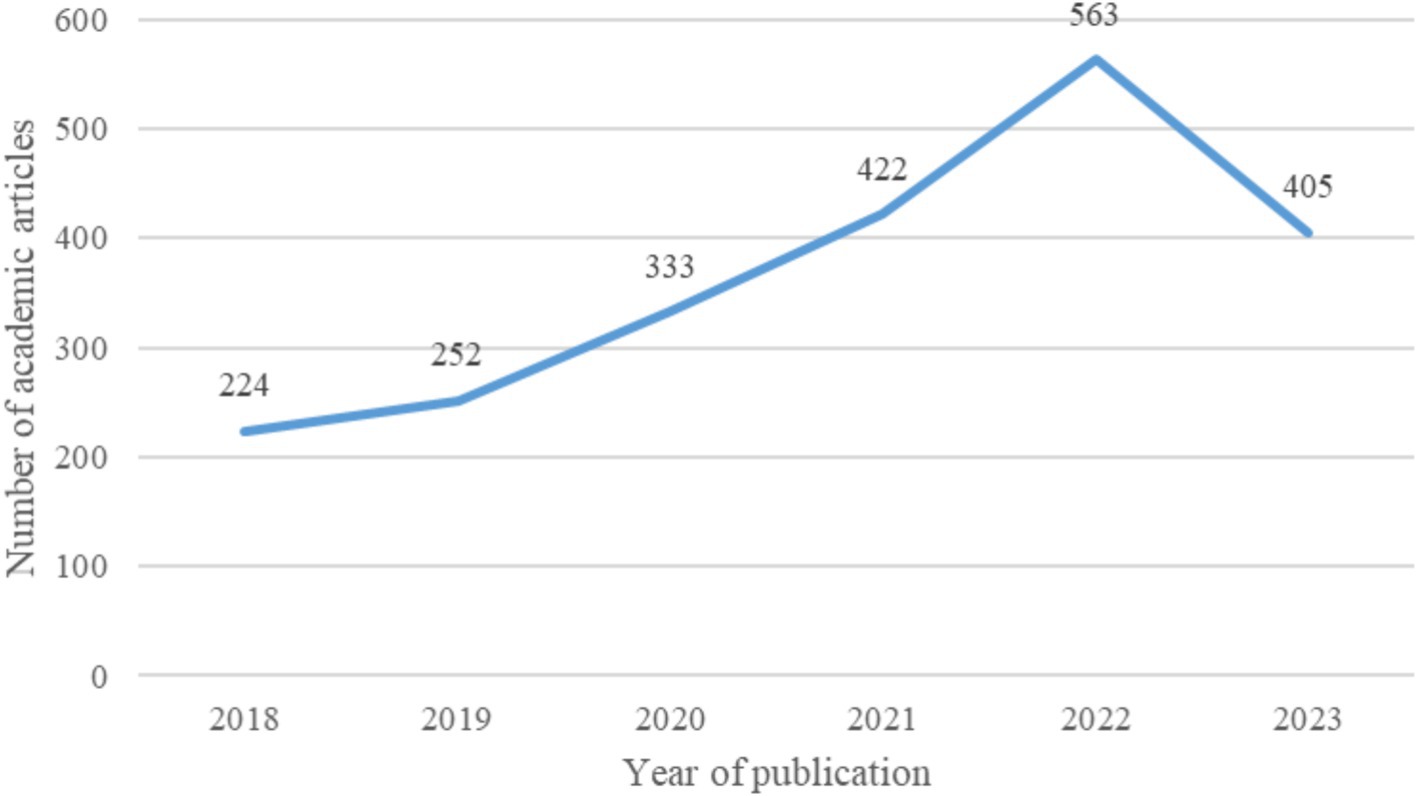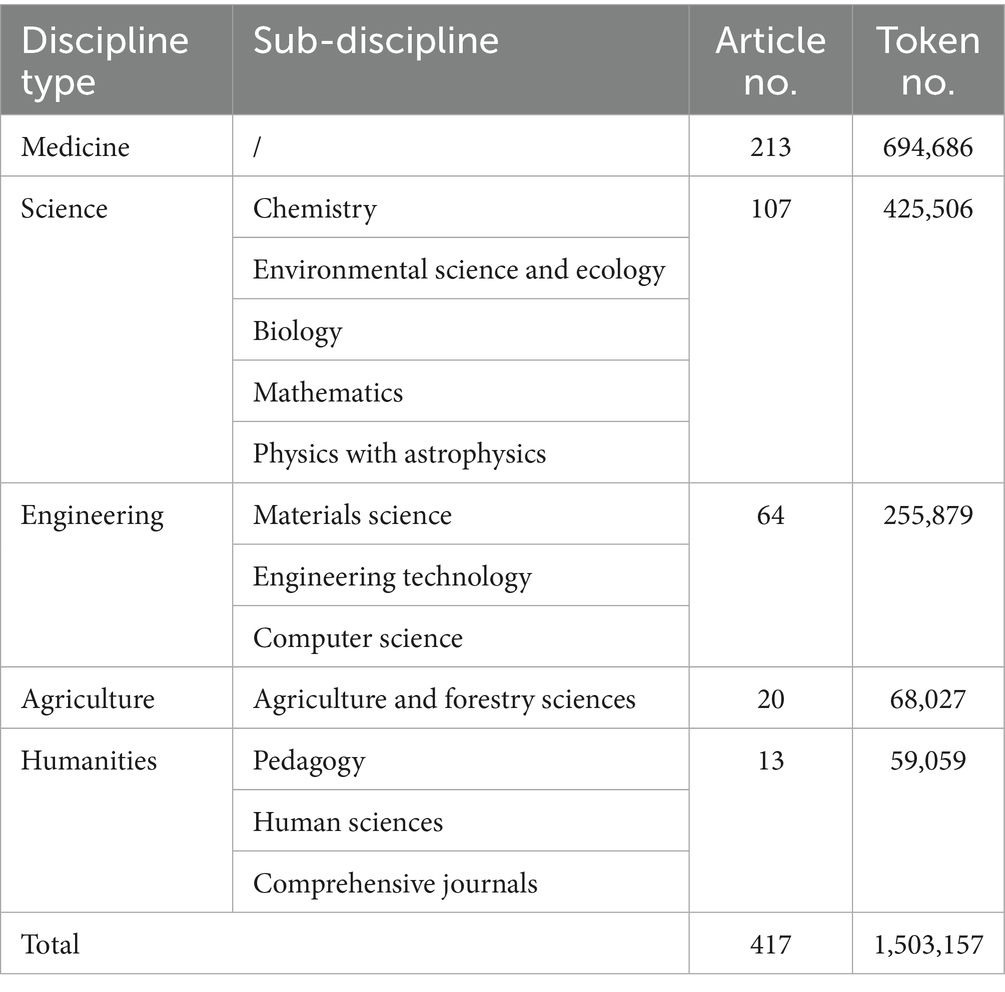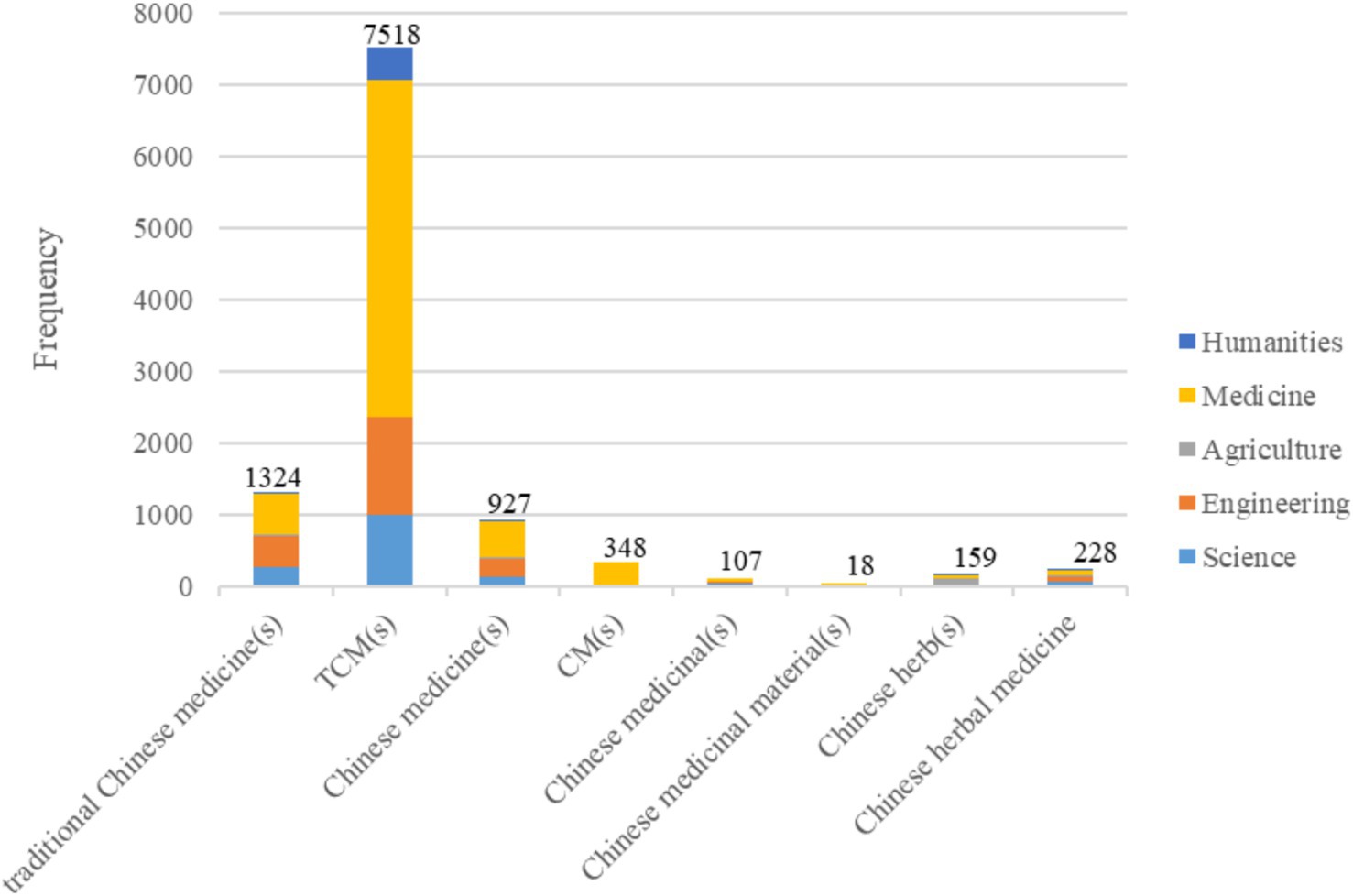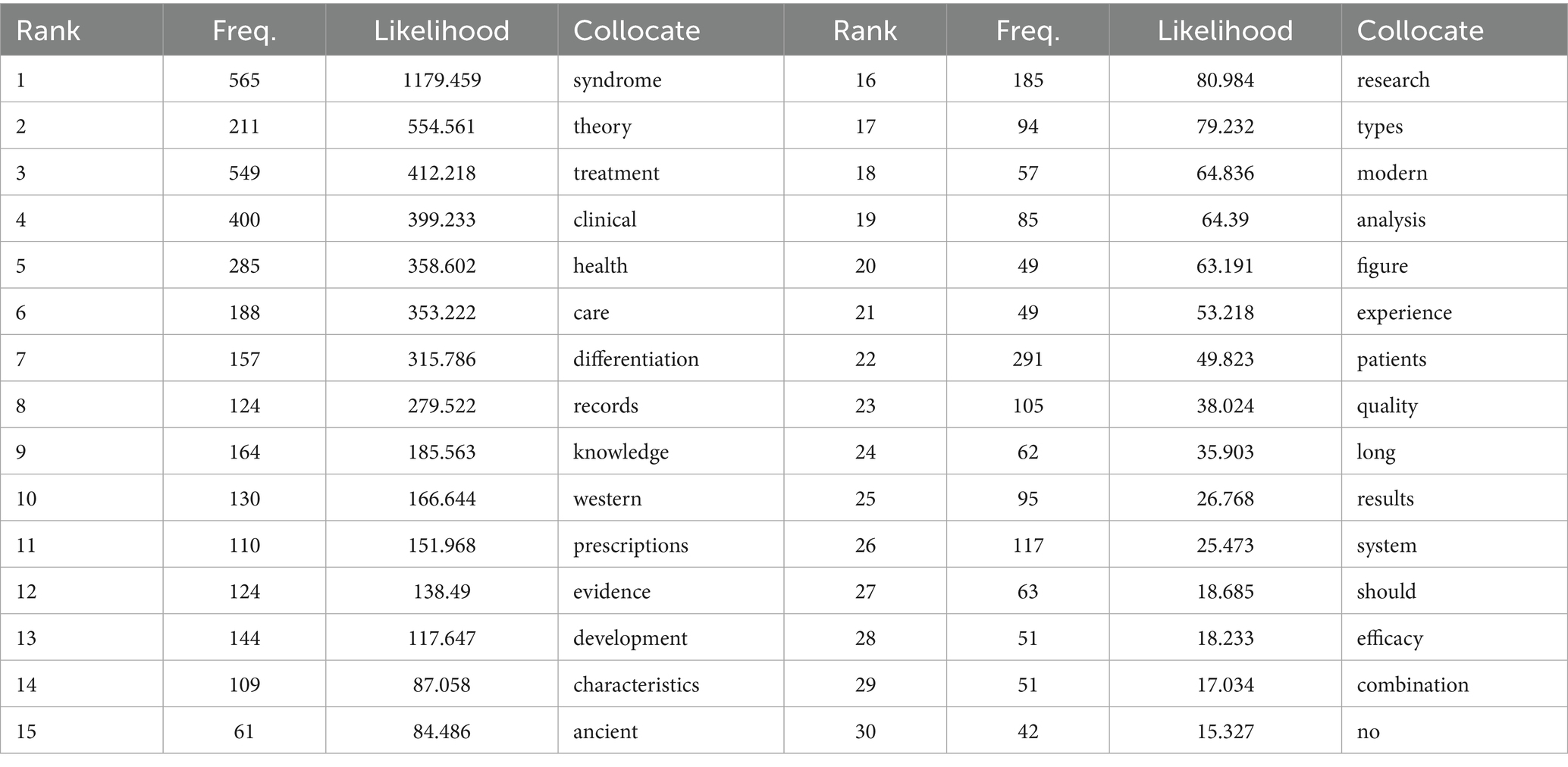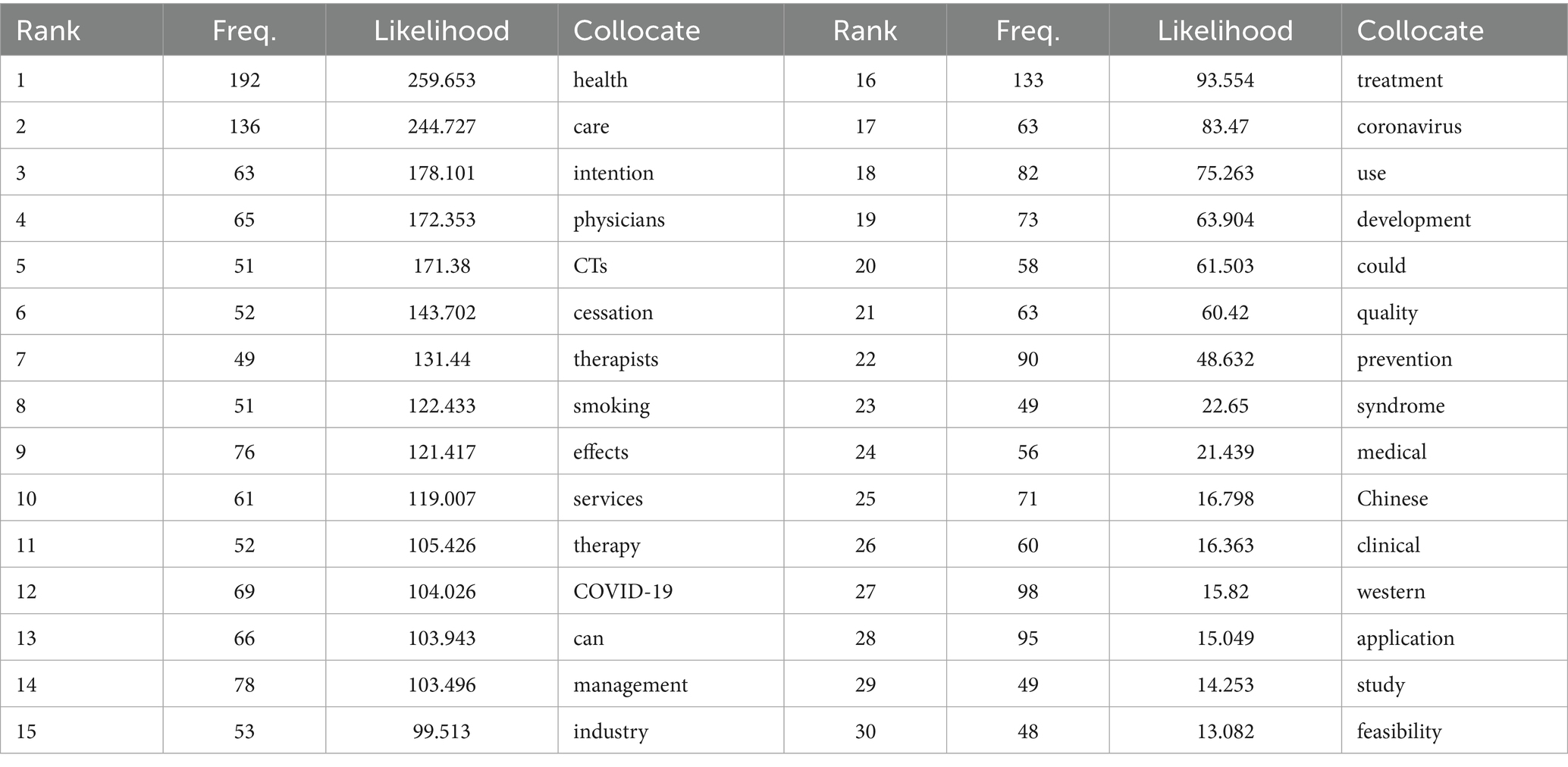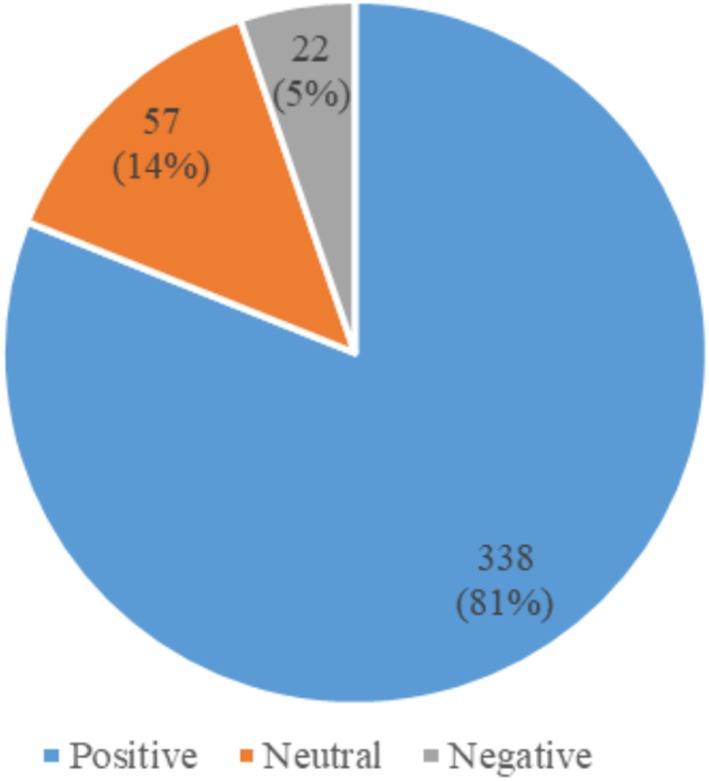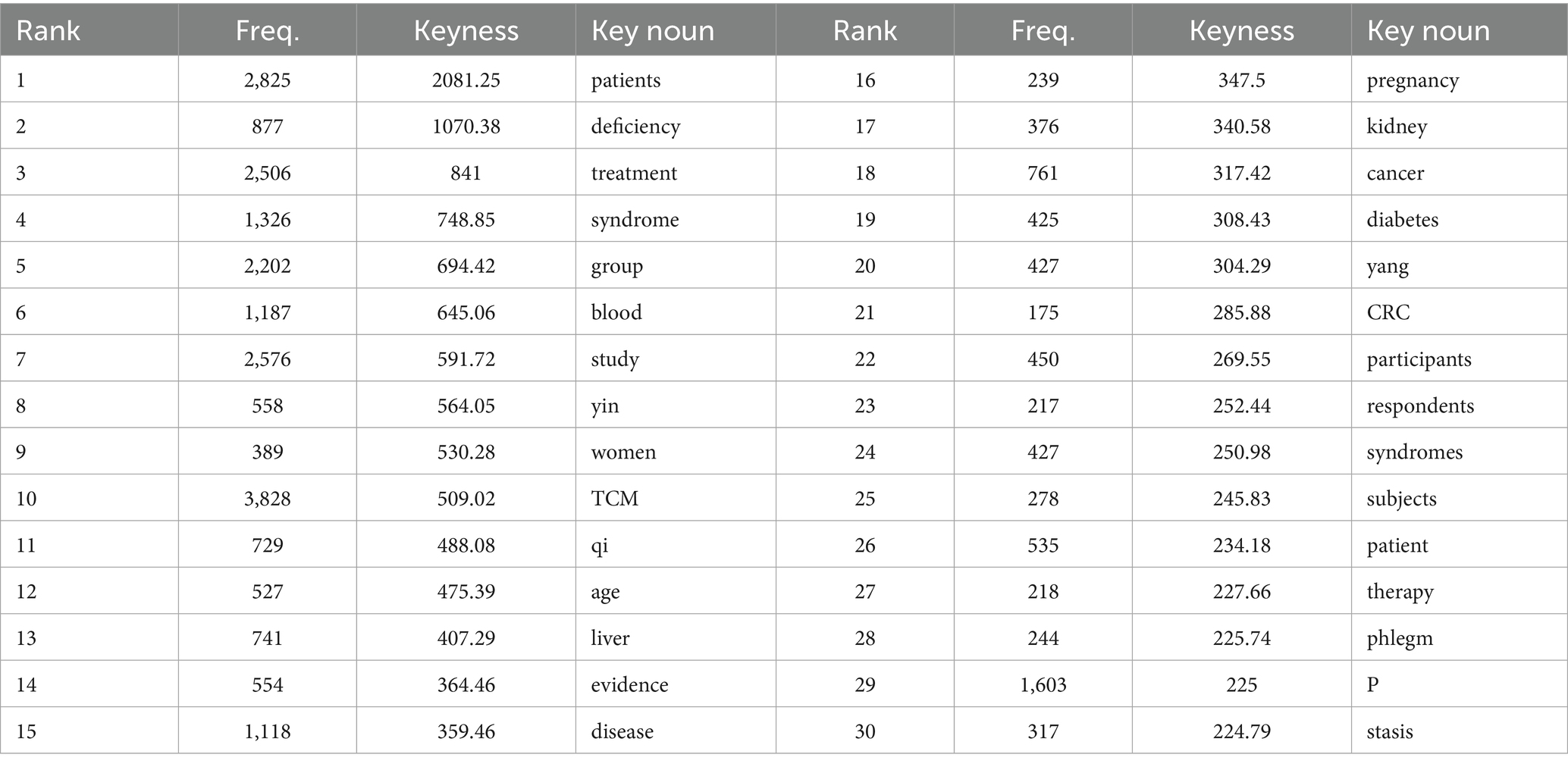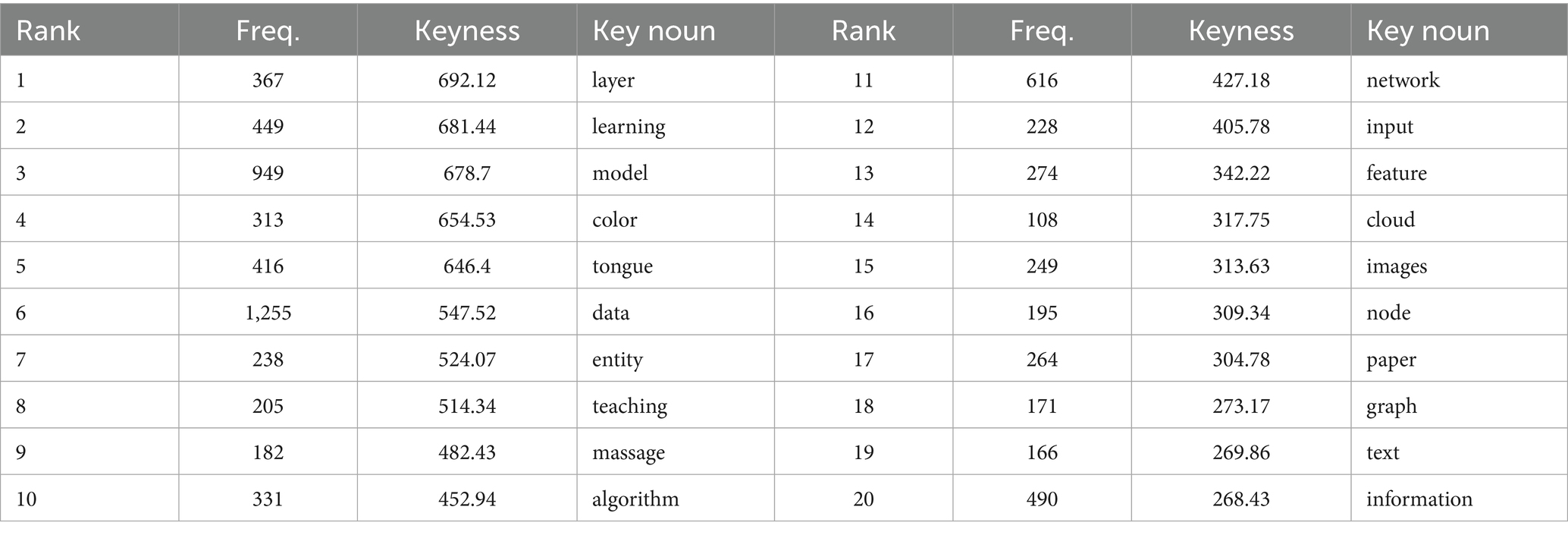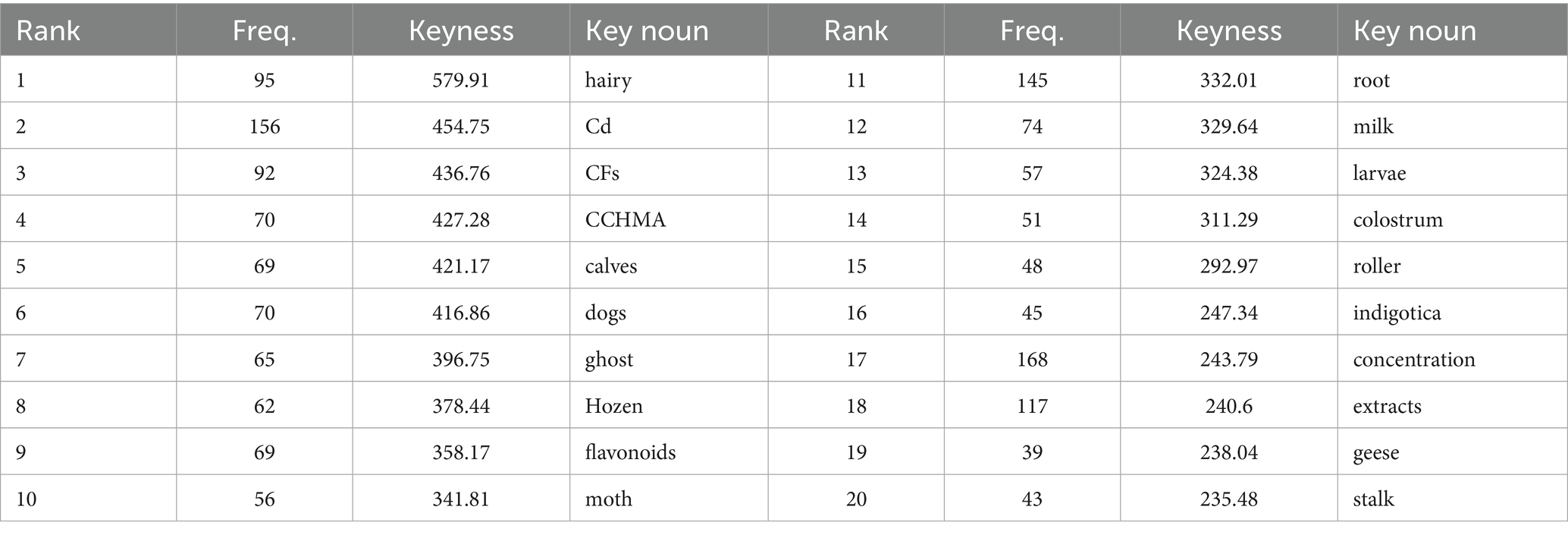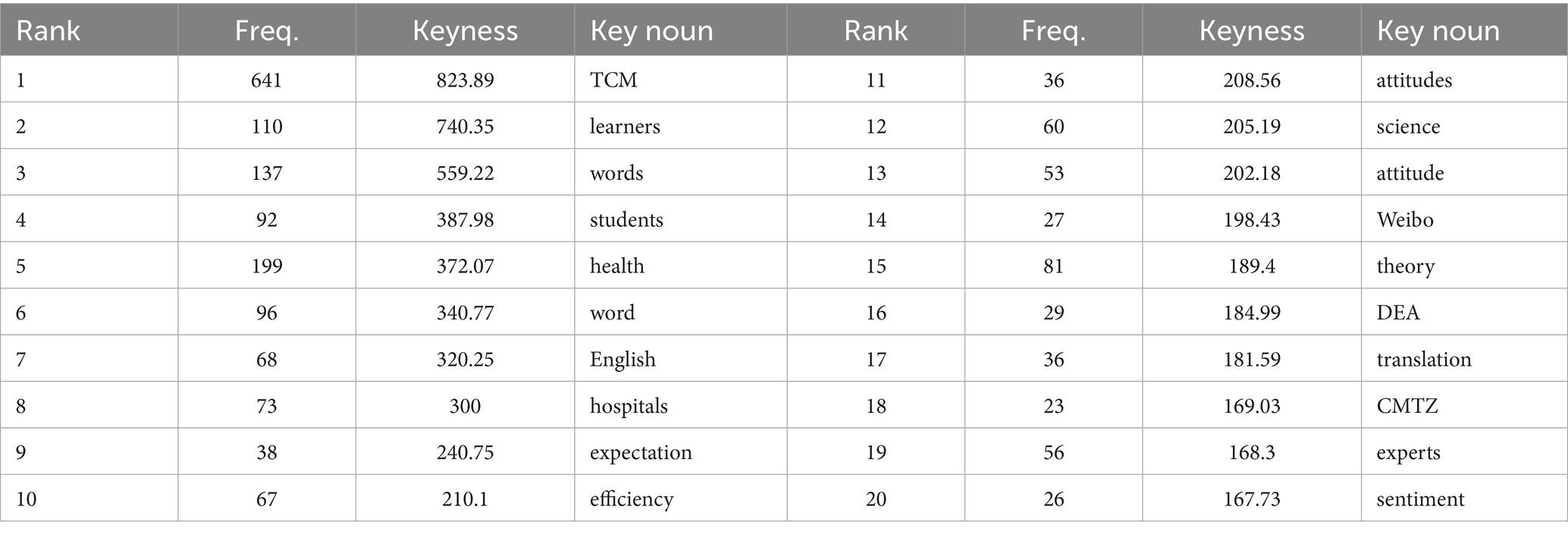- School of Foreign Studies, Guangzhou University of Chinese Medicine, Guangzhou, China
Introduction: TCM has long been subject to international debates regarding its scientific validity, highlighted by studies of its portrayal in particularly media discourse revealing Western perceptions of TCM as “lacking evidence.” The COVID-19 pandemic, however, has markedly increased global attention towards TCM, prompting a re-evaluation of its role.
Methods: Corpus-assisted discourse analysis was employed, with WordSmith 8.0 utilized, to examine perceptions of TCM within international English academic literature from 2020 to 2022 across diverse regions and disciplines.
Results: This study identified three major findings: (1) In the specific context of COVID-19, representations of TCM are consistently positive across all regions, emphasizing its historical credibility, theoretical depth, and perceived efficacy in pandemic response. (2) TCM is represented differently across geographical regions—Asian scholars frequently characterize it as “versatile, reliable, and influential,” while European scholars label it a “non-scientific marginal therapy.” North American and Australian perspectives portray TCM as a dual-sided coin which potentially serves as an “adjuvant alternative,” whereas African scholars seem skeptical, perceiving it as a “low-end therapy.” (3) Disciplinary variation is also observed, with medicine, science, engineering, agronomy and humanities displaying distinct research foci and thus representational tendencies.
Discussion: These findings underscore the complex interplay between medical systems, cultural and geographic proximity, institutional factors, status quos of TCM research and practice as well as disciplinary conventions in the international academic representation of TCM, which contribute valuable insights into its evolving global scientific status and integration into modern healthcare.
1 Introduction
As a holistic healthcare system developed over millennia, traditional Chinese medicine (TCM) integrates therapeutic practices with broader cultural and philosophical conceptions, constituting an important health, economic, technological, cultural and ecological resource in China. In the international context, however, TCM has often been subject to skepticism regarding its scientific validity, portrayed as “non-scientific” or “alternative,” exemplified by WHO’s ICD-11 controversy (Cyranoski, 2018) and FDA’s classification of herbal products as dietary supplements (U.S. Food and Drug Administration, 2022). Such perceptions have posed significant challenges to the global dissemination and acceptance of TCM technologies and culture. Following the outbreak of COVID-19 in late 2019, TCM was soon officially incorporated into China’s “Diagnosis and Treatment Protocol for Novel Pneumonia (Trial Version 3)” in January, 2020. Additionally, TCM formulations, were approved for use in several countries, including Singapore, Thailand, and Australia, as part of COVID-19 treatment regimens. TCM’s integration into pandemic responses, both domestically and internationally, have brought renewed global attention, potentially shifting prior perceptions and inviting re-evaluation of its role within modern healthcare systems.
Previous research on TCM’s global representation remains heavily concentrated on media discourse, with images constructed outside China and qualitative methods predominating. These studies consistently reveal regional variation: Chinese sources frame TCM positively, emphasizing scientific credibility and cultural heritage, whereas Western sources tend to portray it more cautiously, highlighting questions of evidence and regulatory oversight (Chen et al., 2022; Luo, 2024). Nevertheless, the East–West distinction is often over-simplified, and more nuanced cultural and disciplinary differences are rarely explored.
Disseminating TCM knowledge through channels such as academic literature, conferences and organizations, academia holds the natural right to speak about TCM. TCM representation can and should, undoubtedly, be examined from an academic perspective. However, almost no systematic exploration of the academic representation of TCM across different regions and disciplines has been found. In the “Guideline for the Revitalization and Development of TCM” issued by China’s State Council in February, 2023, it was emphasized that the participation of TCM in international cooperation for the prevention and control of major infectious diseases should be strengthened. Therefore, a study of international academic community’s representation of TCM during the post-pandemic era is of particular significance to promoting the international communication and academic development of TCM.
Applying corpus-assisted discourse analysis, this study examines the general perception of TCM and its role in COVID-19 during the post-pandemic era in international English academic discourse, and the differences in the attitudes and research focuses of scholars from various cultural and disciplinary backgrounds on TCM. By addressing these questions, it seeks to contribute new perspectives on the modernization and internationalization of TCM, offering insights into how traditional medical knowledge systems negotiate their place within global scientific discourse.
The remainder of this paper is organized as follows: Section 2 reviews the existing literature on TCM representation in various text types, corpus approaches to TCM representation research and studies of the representation of alternative medicines; Section 3 describes the research design, including data collection, corpus construction, research questions, research methods and research procedures; Section 4 presents the findings and the implications of the results; and Section 5 concludes the study.
2 Literature review
2.1 TCM representation in various text types
The representation of TCM has been investigated in media, educational, and policy texts, with most research to date conducted by Chinese scholars.
2.1.1 TCM representation in media discourse
Media discourse constitutes the most extensively explored domain in TCM representation studies. Based on corpus-assisted discourse analyses and content analyses, Pan (2024a, 2024b) demonstrated that Chinese media consistently frame TCM positively, emphasizing its scientific legitimacy, cultural heritage, and integration into modern healthcare. In contrast, Western media often adopt a cautious tone, portraying TCM as an alternative or complementary practice and occasionally highlighting concerns regarding scientific validation or regulatory oversight. Tang et al. (2025) conducted a quantitative content analysis of TCM news pieces from countries with different cultural profiles, and revealed that national cultural orientations, such as uncertainty avoidance, partly influence how TCM is framed across different countries. In addition, studies of social and online media reveal competing stances on TCM. For example, Chen et al. (2018) analyzed global social-media discussions on TCM and found that debates tend to fragment along cultural lines, with adherents forming insular “public spheres” around pro- or anti-TCM sentiments. Similarly, Wang et al. (2024) examined nearly 2,000 Zhihu (a Chinese Q&A site) posts on TCM for COVID-19 and found that most lay users expressed positive attitudes rooted in personal experience and media influence, while medical professionals were more supportive than skeptics.
2.1.2 TCM representation in educational and policy discourse
In educational and knowledge dissemination contexts, research examines platforms such as encyclopedias and public signage. Ye et al. (2020) focused on how TCM is presented in a collaborative online encyclopedia, highlighting the coexistence of cultural pride and scientific caution in framing TCM. Chinese-oriented platforms and institutional materials typically emphasize TCM’s historical significance and effectiveness, whereas English-language sources present more balanced or skeptical accounts. Policy and governmental discourse analyses similarly show that Chinese governmental narratives position TCM as both a scientific achievement and a soft power instrument, aligning it with national health strategies and international diplomacy (Yang et al., 2022). In contrast, Western regulatory frameworks categorize TCM under complementary and alternative medicine, emphasizing evidence-based integration (Qu et al., 2022).
Obviously, research across various text types converges on the point that the representation of TCM is context-dependent, shaped by both cultural identity and information sources, with Chinese narratives generally conveying a supportive view.
2.2 Corpus approaches to TCM representation research
Given the discourse differences noted above, researchers have increasingly turned to corpus approaches which enable the analysis of large-scale collections of TCM-related texts to uncover recurring linguistic patterns, framing tendencies, and subtle biases that might escape manual reading. Ge and Tian (2022) constructed a corpus of English-language China Daily reports from 2020 to examine its messaging strategy surrounding TCM during the COVID-19 pandemic. Using WordSmith Tools to extract keywords, lexical patterns, and concordance lines, they demonstrated that the anti-epidemic context was leveraged to construct a science-backed and heroic image of TCM. Additionally, Zhang and Luo (2023) examined the international portrayal of TCM using the News on the Web (NOW) corpus, covering English news texts from 2010 to 2020. Through collocation analysis, it was found that while TCM was frequently associated with positive descriptors, it was also occasionally linked to skeptical terms like “quackery” and “unproven.” A cautious stance was also revealed in Western reporting, as evidenced by the high frequency of low-value modal verbs.
These studies suggest that corpus methods can effectively capture the evaluative framing and narrative architecture of media, providing methodological insights for the exploration of TCM representation in academic discourse in this study.
2.3 Studies of the representation of alternative medicines
The inclusion of TCM in Complementary and Alternative Medicine (CAM) discussions in many Western countries means that any stereotype might likely color perceptions of TCM as well. Therefore, understanding TCM’s portrayal requires situating it within the wider context of how alternative medicines in general are represented. Research on the representation of alternative medicines primarily highlights diverse media and policy depictions.
Lavorgna and Di Ronco (2018), through discourse analysis of Italian newspaper reports, observed a hybrid framing of alternative medicines: while some articles amplified their potential, others conveyed regulatory caution, often quoting health officials. This ambivalence was argued to stem from limited scientific literacy among journalists and the scarcity of authoritative expert voices in the coverage. Koppel and Uibu (2022) conducted a qualitative media analysis on profiles of three prominent CAM doctors in Estonia. It was found that journalists initially framed these practitioners as marginal or pseudoscientific, but gradually shifted to portray them as culturally resonant and medically credible, suggesting a normalization of CAM figures in public discourse aligned with growing public interest. In the policy sphere, Danell (2018), analyzing Swedish political debates, revealed that CAM was increasingly framed not only as a therapeutic option for chronic conditions, but also as a matter of individual rights. Politicians across parties cited patient autonomy, cultural pluralism, and healthcare system flexibility as justifications for its inclusion, despite unresolved scientific debates.
In summary, three major gaps can be identified from previous research. Firstly, TCM representation research has predominantly focused on media discourse, while academic discourse where TCM’s scientific status is most critically evaluated has received little attention. In addition, while geographical variation is a consistent observation across studies, these comparative analyses often simplify the East–West distinction, potentially overlooking nuanced differences within regions and disciplines. Secondly, while corpus methods are not novel in studies of image construction, current research has primarily centered on TCM represented by either Chinese or overseas media, with a dearth of cross-cultural comparisons and an over generalization of TCM “images.” Thirdly, the literature of the representation of alternative medicines underscores the complexity of general Western attitudes towards CAM, but there remains space for a more focused analysis on TCM’s unique position. In terms of research methods, much work is qualitative or region-specific, with a systematic corpus-assisted study of TCM representation in international academic discourse failing to receive the deserved attention.
3 Research design
In order to determine the temporal scope of this study, a preliminary analysis of publication trends from 2018 to 2023 was conducted, as shown in Figure 1.
This data-driven approach revealed a significant surge in TCM-related English academic publications included in the core collection of Web of Science (WOS) between 2020 and 2022, corresponding to the heightened international attention following the COVID-19 outbreak. Accordingly, the three-year post-pandemic period was selected for focused analysis.
3.1 Data collection
A corpus of international English academic articles on TCM was assembled, with data collected from the core collection of WOS (SCI, SSCI, A&HCI, ESCI, CPCI-S, CCR, IC) and MEDLINE®, from January 1st, 2020 to December 31st, 2022. Conventional translations of “中医药” including “(traditional) Chinese medicine*,” “(T)CM*,” “Chinese medicinal*,” “Chinese medicinal material*,” “Chinese herb*” and “Chinese herbal medicine*” were searched in the title in May, 2024 (“*” ensures the inclusion of corresponding plural forms). Selection prioritized English-language peer-reviewed articles, conference proceedings, and policy reports that explicitly discuss TCM, but excluded review articles, literature reviews and patient stories. In addition, articles that mention TCM only tangentially were also excluded to ensured TCM as a main topic, and abstracts were checked for relevance when necessary. After deduplication and filtering, 417 articles were ultimately harvested.
3.2 Corpus construction
Only the main texts (excluding metadata such as references, tables, and acknowledgments) of the above articles were retained and saved in TXT format. EmEditor was employed to batch-clean the raw data by removing non-textual elements, normalizing formatting inconsistencies (e.g., irregular spacing, paragraphing), and unifying encoding standards to ensure corpus readability and consistency. After data cleansing, a corpus of TCM-related international English academic articles (hereinafter referred to as “CTIEAA”) was established. CTIEAA encompasses 1,503,157 tokens (a token refers to each occurrence of a word, number, or punctuation symbol within the corpus) across 13 disciplinary areas, including medicine, chemistry, biology, engineering, pedagogy and humanities, to name just a few. Considering the broad range of disciplines involved, CTIEAA was further classified according to the Subject Catalog of Degree Granting and Personnel Training issued by China’s Academic Degrees Committee of the State Council and Ministry of Education, hence discipline-specific sub-corpora, namely medicine, science, engineering, agriculture and humanities, as displayed in Table 1.
3.3 Research questions
In line with aforementioned research objectives, the following three research questions are proposed:
(1) What characterizes international scholars’ general perception of TCM and its role in COVID-19 during the three-year post-pandemic era?
(2) What are the differences in attitude towards TCM in international English academic discourse in various regions?
(3) What are the differences in research focus on TCM in international English academic discourse in various disciplines?
3.4 Research methods
Corpus linguistics refers to the computer-aided study of extensive collections of transcribed utterances or written texts. Based on a large amount of detailed linguistic evidence, it helps reduce researcher subjectivity, and, when properly implemented, can enhance systematicness and credibility of research. Since traditional discourse analysis has been criticized for its fragmented linguistic data and strong subjectivity (Baker et al., 2008), corpus methods, serve as a pivotal approach in analyzing the discursive construction of images (Xu and Wei, 2024).
WordSmith 8.0 was selected as the research tool as it offers integrated functions essential for this study, including concordancing (generation of a list of all occurrences of a search term presented with its immediate textual context), wordlist generation, keyword (a word whose frequency is significantly higher in the target corpus compared to a reference corpus) extraction (with log-likelihood scoring), cluster (a contiguous sequence of words, or “n-grams,” extracted from corpus data) analysis and collocation (a statistically significant co-occurrence of two or more words within a specified span) measurement (McEnery and Hardie, 2012). Compared with other corpus tools like AntConc and Sketch Engine, WordSmith provides built-in keyness calculation, transparent parameter control, and straightforward logging of search steps, facilitating replication. Its cluster function enables efficient retrieval of contiguous 2–6 word sequences, aligning closely with our research focus on clusters and evaluative patterns across regions.
In addition to quantitative measures, sentiment toward TCM was assessed based on concordance lines extracted for the most conventional translations of “中医药” (such as “TCM” and “traditional Chinese medicine,” which remain to be figured out later), within a concordance window of ±20 words. Sentiment was categorized as positive endorsing efficacy, safety, or scientific validity (e.g., “TCM offers effective therapies”), negative expressing skepticism or caution (e.g., “lack of rigorous evidence for traditional Chinese medicine”), or neutral providing factual descriptions without overt evaluation (e.g., “This study compared TCM and conventional therapies in clinical settings”). Two independent coders, including a native English-speaker and the author, initially labeled a random sample of 400 concordance lines. Inter-coder reliability was high (Cohen’s κ ≈ 0.82), and disagreements were resolved through discussion. Labeling of the remaining lines was completed by the author individually, following the established criteria.
3.5 Research procedures
A three-step corpus analysis procedure was employed to systematically examine international academic discourse on TCM across regions and disciplines.
First, collocation analysis was performed on the most conventional translation of “中医药,” generating its significant evaluative content collocates using the log-likelihood test (LL > 3.84, p < 0.005). And the concordances of these collocates were utilized to investigate international scholars’ overall perceptions of TCM. Pandemic-related articles in CTIEAA were further screened out, and the significant evaluative content collocates of the most conventional translation of “中医药” in these articles were generated, for a more comprehensive understanding of international scholars’ perception of the connection between TCM and COVID-19.
Secondly, international scholars’ general sentiments towards TCM were assessed. After the construction of region-specific sub-CTIEAAs, subject-predicate (S-P) clusters starting with the conventional translations of “中医药” as the search term were extracted via WordSmith’s cluster tool, to discern the differences in attitude of scholars from each continent.
Lastly, keyword analysis compared word frequencies in each discipline-specific sub-CTIEAA against the other four sub-corpora combined as a reference corpus (detailed rationale provided in Section 4.1.4.1), using log-likelihood (LL > 3.84, p < 0.005) test. Selected keywords were then examined through concordance lines to investigate the respective research focus on TCM in various disciplines.
4 Results and discussion
4.1 Results
4.1.1 General perception of TCM in international English academic articles
The aforementioned conventional translations of “中医药” in academic discourse were used as search terms to examine their distributions in each discipline-specific sub-CTIEAA, as shown in Figure 2.
Figure 2 reveals that “traditional Chinese medicine,” “TCM,” “Chinese medicine,” “CM,” “Chinese medicinal,” “Chinese medicinal material,” “Chinese herb,” “Chinese herbal medicine,” along with their plural forms, are all distributed in CTIEAA. “TCM(s)” is the most frequent, far exceeding the combined frequency of other translations. Except for the agricultural sub-CTIEAA where “Chinese herb(s)” ranks the 1st, the frequency of “TCM(s)” in other discipline-specific sub-corpora is significantly higher. This indicates that “TCM(s)” is most conventionally used in international English academic discourse by various disciplines to refer to “中医药,” followed by “traditional Chinese medicine(s)” and “Chinese medicine(s).”
“TCM(s)” as the node word, the top 30 evaluative content words collocated with it in CTIEAA were generated, with a span length of five words to either side and a minimum frequency of 40, as shown in Table 2.
Judging only from the context-free collocates in Table 2, the perception of TCM in international English academic articles generally displays the following eight characteristics.
First, diversity and individualization of diagnosis and treatment. Collocates such as syndrome, differentiation, prescriptions and types indicate that TCM attaches importance to differential diagnosis based on syndrome differentiation, follows the principle of “one prescription for one person,” and provides personalized therapeutic regimens for a variety of diseases.
Second, theoretical, knowledge-based and academic nature. Collocates such as theory, knowledge, development and research imply a complete theoretical system and rich medical knowledge of TCM which stands as the object of academic research.
Third, extensive clinical application. Collocates such as treatment and clinical show that TCM has a wide range of applications in the clinical diagnosis and treatment of diseases.
Fourth, scientificity and effectiveness. Collocates such as records, evidence, analysis, figure, quality, results and efficacy indicate that a large number of scholars have conducted assessments of TCM effects, providing scientific evidence for its effectiveness and safety.
Fifth, systematicity and holistic view of the medical system. Characteristics and system emphasize that TCM is an independent medical system with systematic and holistic features.
Sixth, a time-honored history. Collocates such as ancient and long indicate that TCM boasts a long history and profound cultural traditions.
Seventh, integration with Western or modern medicine. Collocates such as modern and combination reflect that TCM is engaged in more scientific analysis and research through exchanges and cooperation with modern medical methods.
Last but not least, it’s noteworthy that negative perceptions of TCM also present in international academic discourse. Health, care and Western may imply the marginal status of TCM as a health care tool as opposed to modern medicine. Collocates such as experience, should and no, though ranking low, may pertain to doubts and disputes about the scientificity of empirical medicine.
For deeper insights into the above findings, a typical collocate was selected for each aspect, and a further analysis of some of their concordances in CTIEAA provide specific contextual evidence for international scholars’ overall perceptions of TCM in the past 3 years, as excerpted in Table 3.
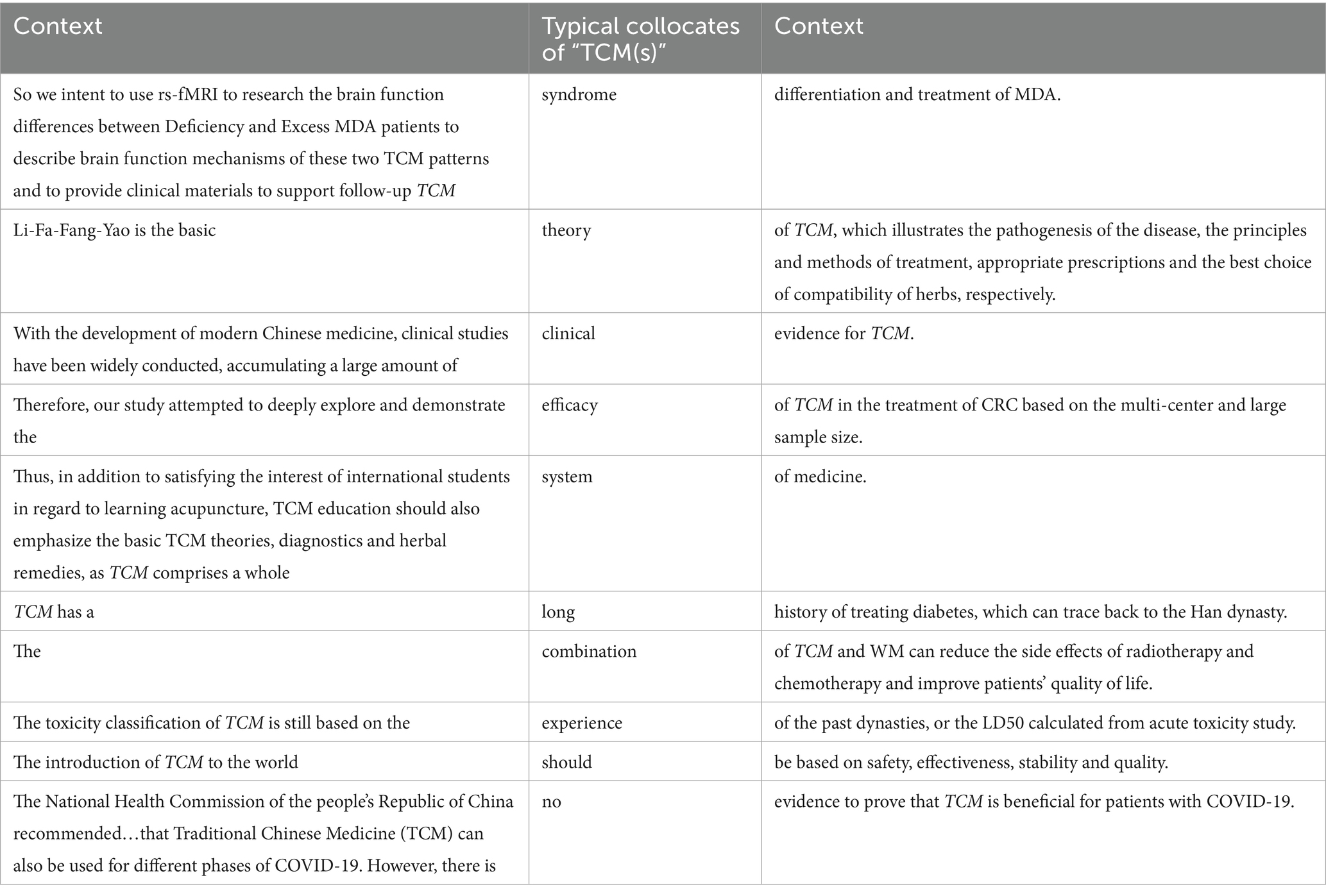
Table 3. Concordances of typical collocates of “TCM(s)” in international English academic discourse (excerpt).
In a nut shell, international scholars have a multidimensional understanding of TCM, reflecting both respect for its history and theory, and the pursuit of its modern application and scientific verification. TCM as a whole has been portrayed as a medical system with a time-honored history, rich theory, extensive clinical practice, emphasis on individualized treatment and overall health, potential for modern application in specific areas, independent system and unique features. Nevertheless, further scientific research is still needed to improve TCM’s level of standardization and modernization.
4.1.2 Perception of TCM against COVID-19 in pandemic-related articles
To comprehensively understand the perception of the connection between TCM and COVID-19, and its role in combating the pandemic in international academic discourse, a multi-item search was conducted with expressions such as “COVID-19,” “coronavirus,” “epidemic” and “pandemic” as search terms. After a manual checking, 56 pandemic-related articles in CTIEAA were screened out. With “TCM(s)” as the node word, a span length of five words to either side and a minimum frequency of 40, the top 30 evaluative content collocates in the pandemic-related articles were generated, as shown in Table 4.
Effects, COVID-19 and coronavirus rank the 9th, 12th and the 17th, respectively, in the list, indicating the keen interest of international scholars in the relationship between COVID-19 and TCM. To be specific, discussions center on the feasibility and effects of TCM in daily health care, treatment and prevention of COVID-19, and particularly the efficacy of integrated traditional Chinese and western medicine or auxiliary treatment with TCM. Researchers have also examined factors influencing the use (use, application) of TCM to prevent and treat COVID-19, and proposed suggestions for the improvement of TCM management, development, quality safety, services and clinical trials (CTs). Significant collocations such as cessation, smoking and therapy suggest increased focus on TCM smoking cessation therapy in the post-COVID-19 era. What’s worth noting is that can and could, as modal verbs which can reveal authors’ judgment on the possibility of propositions, rank the 13th and 20th, respectively. Therefore, by focusing on these five typical words significantly collocated with “TCM,” a further analysis of some of their concordances in the pandemic-related articles from CTIEAA offer deeper insights into international scholars’ perceptions on the role of TCM against COVID-19, as excerpted in Table 5.
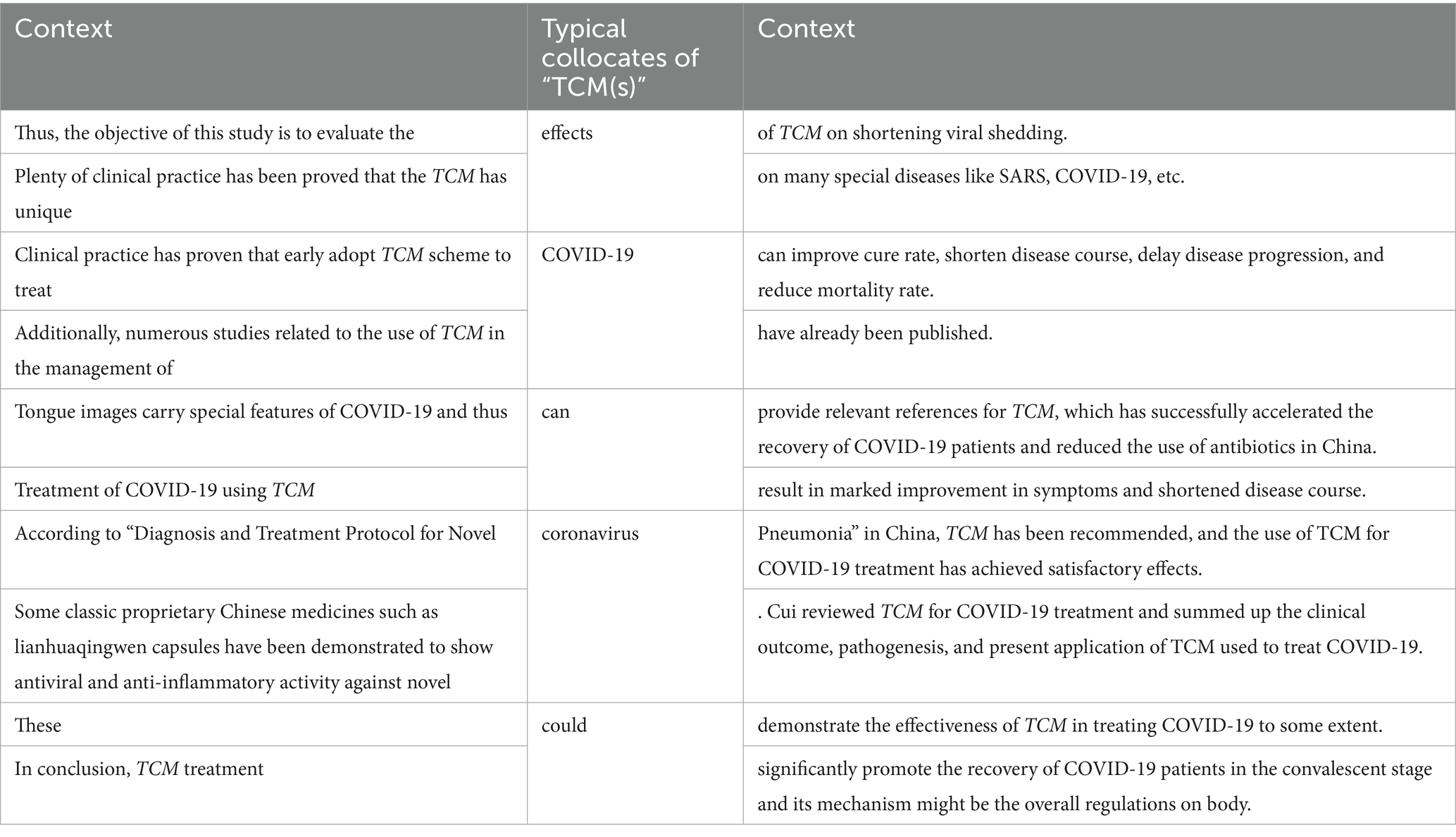
Table 5. Concordances containing effects, COVID-19, can, coronavirus and could in pandemic-related articles (excerpt).
It can be concluded through an analysis of the concordances in Table 5 that international scholars have evaluated the impact of TCM on shortening viral shedding, recognizing its unique efficacy in treating many special diseases like SARS, COVID-19, etc. TCM is also recommended in the “Diagnosis and Treatment Protocol for Novel Pneumonia” for COVID-19 treatment, achieving satisfactory results. Moreover, the extensive publication of articles on COVID-19 treatment with TCM demonstrates that early implementation of TCM strategies can markedly relieve symptoms, shorten disease course, delay disease progression, improve cure rate and reduce mortality. Tongue diagnosis in TCM, based on the manifestation of COVID-19 in tongue images, can accelerate the recovery of patients and reduce antibiotics use. Some classic proprietary Chinese medicines, such as lianhuaqingwen capsules, have shown antiviral and anti-inflammatory effects against COVID-19. The mechanism of TCM treatment involves a holistic regulation of the body, with notable efficacy in the convalescent stage of COVID-19.
4.1.3 Attitudes towards TCM in academic discourse in different regions
This section presents the specific attitudes towards TCM of scholars from the major continents, following an analysis of their general sentiments.
4.1.3.1 Overview of international scholars’ sentiments towards TCM
According to the sentiment type exceeding 50% of the labeled concordance lines, each of the 417 articles in CTIEAA was assigned an overall sentiment classification, and the distribution of international scholars’ sentiments towards TCM is displayed in Figure 3. This procedure integrates localized evaluative patterns into holistic sentiment judgments, following established content analysis practices (Neuendorf, 2017).
As indicated in Figures 3, 337 articles exhibit positive sentiments towards TCM, constituting 80.8% of the total, which indicates a general optimism among international scholars regarding TCM in recent years. No obvious emotional tendencies were found in 57 articles, which account for 13.7%. The remaining 23 articles, though comprising only 5.5%, present concentrated viewpoints: despite a claim to be harmless, some Chinese herbal medicines have not been identified, with unclear pharmacological properties and questionable safety. Many known Chinese medicinals contain toxic and carcinogenic ingredients, the concentration of which is susceptible to the place of production and processing technologies. Concerns extend to the large amount of waste generated during the extraction of and treatment with Chinese medicinals, mainly disposed of through landfills or discharges, which poses teratogenic risks and environmental pollution. In addition, some scholars have hinted at illegal activities in the TCM market, such as the listing of unregistered Chinese medicinals, unauthorized addition of synthetic dyes, and lax supervision of drug quality and safety. The efficacy and reproducibility of TCM therapy are also questioned for lack of prospective research, with frequent side effects seen as confirmation of the uncertainty of TCM theories. The lack of accuracy in syndrome differentiation is believed to not only affect the treatment effect, but may also aggravate patients’ conditions.
In order to further understand the differences in attitude towards TCM of scholars from each continent, we classified the 417 articles by the nationality of the first author, building region-specific sub-CTIEAAs. Clusters were generated with the conventional translations of “中医药” as the search term (repeated trials proved that five-word clusters could express complete meanings with a relatively small number of words, which are considered the best choice). S-P structures were then screened out, and, combined with the extended context of their concordances, an intuitive appraisal of TCM by scholars from different continents can be obtained.
4.1.3.2 Asian scholars’ attitudes towards TCM
The Asian sub-CTIEAA, containing a total of 1,360,010 tokens, encompasses 398 articles. Both the minimum frequency and range were set to “2” to maximize the generation of analytic targets. After those of little appraisal significance filtered out, the top 20 five-word S-P clusters with the conventional translations of “中医药” as the search term in the Asian sub-CTIEAA are depicted in Table 6.
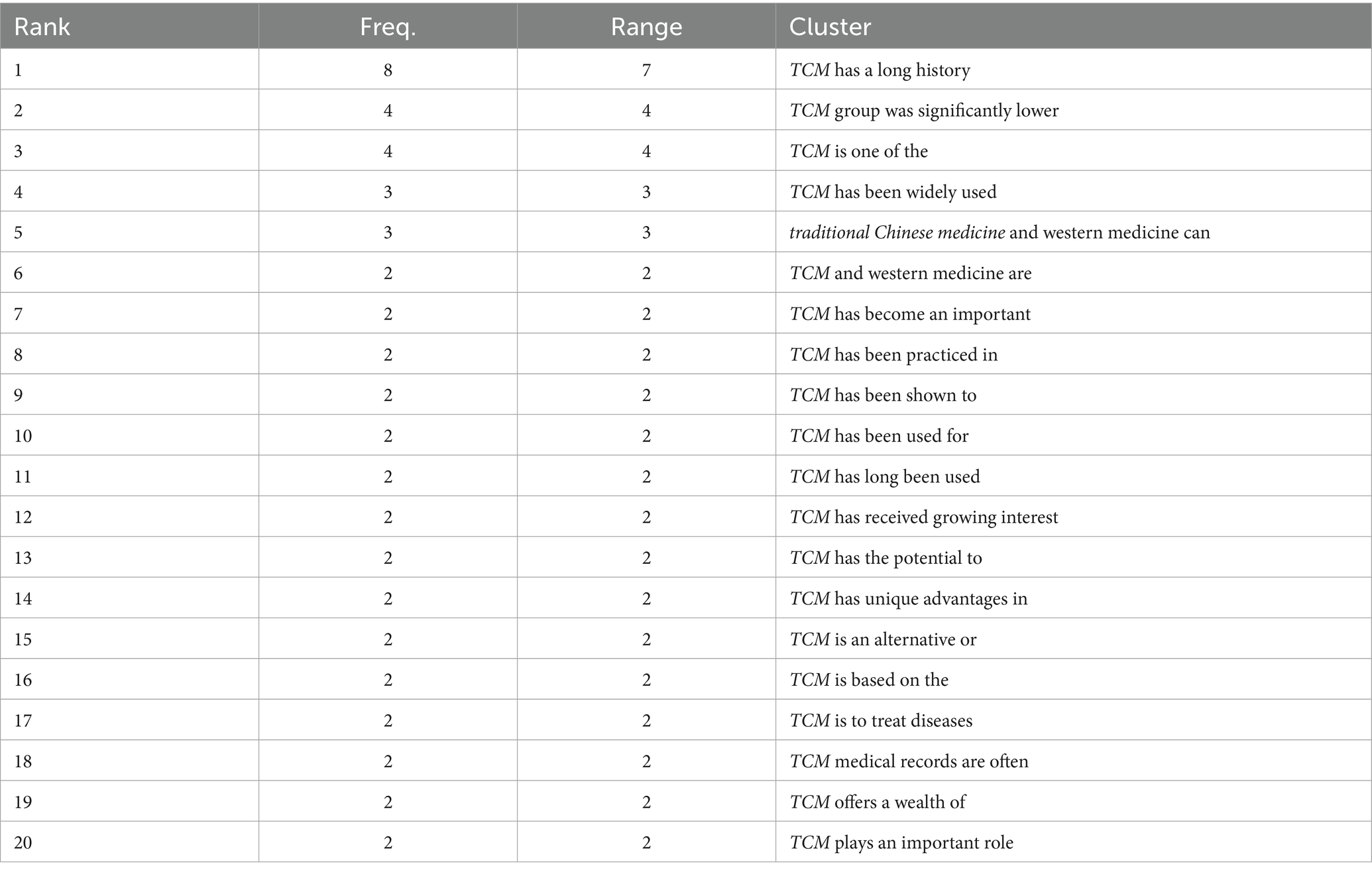
Table 6. Top 20 five-word S-P clusters containing the conventional translations of “中医药” in the Asian sub-CTIEAA.
Asian scholars generally perceive TCM as a widely used practice in China and other Asian countries which boasts a history spanning thousands of years in healthcare and disease prevention and treatment. TCM is noted for its efficacy, safety and affordability. Controlled studies suggest that long-term treatment with Chinese medicinals can prolong survival time, improve remission rates, reduce recurrence, and extend recurrence-free survival periods. In Asia, TCM is regarded an important traditional medical or supportive intervention means, and the Chinese government has long been advocating the development of both traditional Chinese and Western medicine. On the other hand, as a complementary or alternative therapy in modern medical system, TCM practices have yet to be well integrated even in the primary care in many Western countries. But Chinese medicinals can significantly rehabilitate patients in the recovery stage of COVID-19, with potential preventive and therapeutic applications. They also provide rich natural resources for pharmaceutical compounds. However, the lack of knowledge about TCM may raise efficacy concerns and thus reduce patients’ willingness to adopt TCM therapies, because, after all, the toxic and side effects do exist.
4.1.3.3 European scholars’ attitudes towards TCM
The European sub-CTIEAA, comprising 8 articles, totals 43,004 tokens. To accommodate the size differences among the continent-specific sub-CTIEAAs, the minimum frequency and range were adjusted to “1” as appropriate for more completed and operable results. The top 10 five-word S-P clusters with the conventional translations of “中医药” as the search term in the European sub-CTIEAA are presented in Table 7.
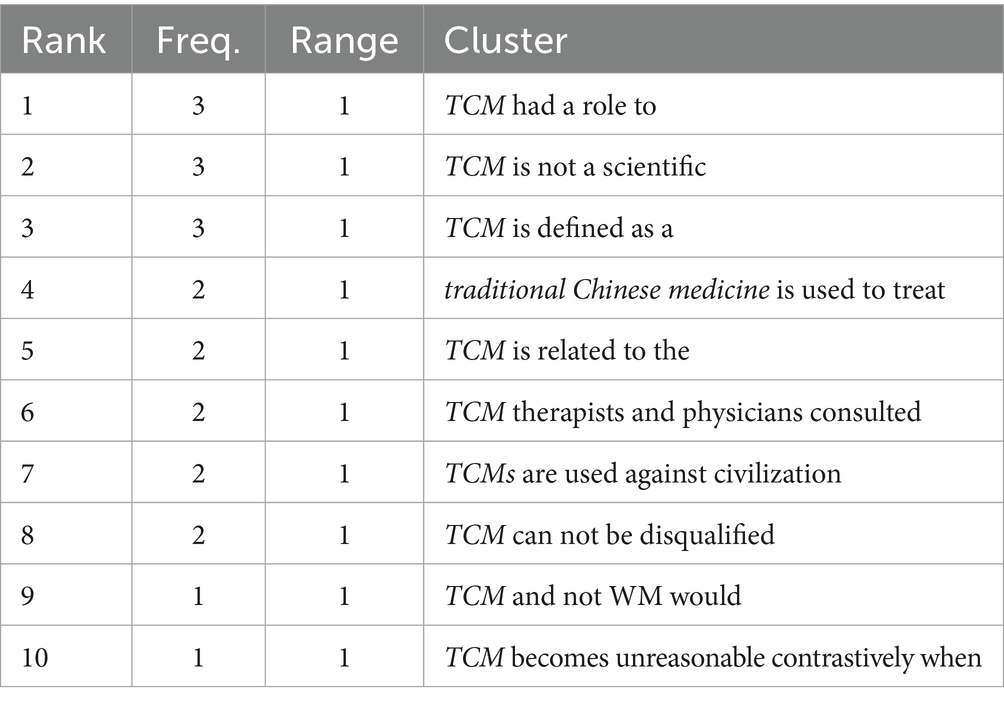
Table 7. Top 10 five-word S-P clusters containing the conventional translations of “中医药” in the European sub-CTIEAA.
European scholars compare the opinions of Chinese physicians and Western doctors on the role of Chinese medicinals in different stages of COVID-19, finding a significantly higher proportion of the former who believe in the effectiveness of Chinese medicinals in the preventive and acute stages than that of the latter, though both acknowledge their contributions to COVID-19 recovery. However, some European scholars have directly questioned TCM, pointing out that judged from the perspective of the evidence in its favor, TCM can not be disqualified as non-scientific. However, because the evidence is extremely insufficient, TCM is after all “not a science.” “There is nothing inherently irrational about resorting to the so-called traditional medicines in cultural contexts where science-based medicine is historically absent. The usage of TCM becomes unreasonable contrastively when compared to other clinical practices.” (de Felipe, 2021, p. 1367).
4.1.3.4 African scholars’ attitudes towards TCM
The total token count of the African sub-CTIEAA is 31,757, with 8 articles included. The minimum frequency and range kept at “1,” the top 10 five-word S-P clusters with the conventional translations of “中医药” as the search term in the African sub-CTIEAA are displayed in Table 8.
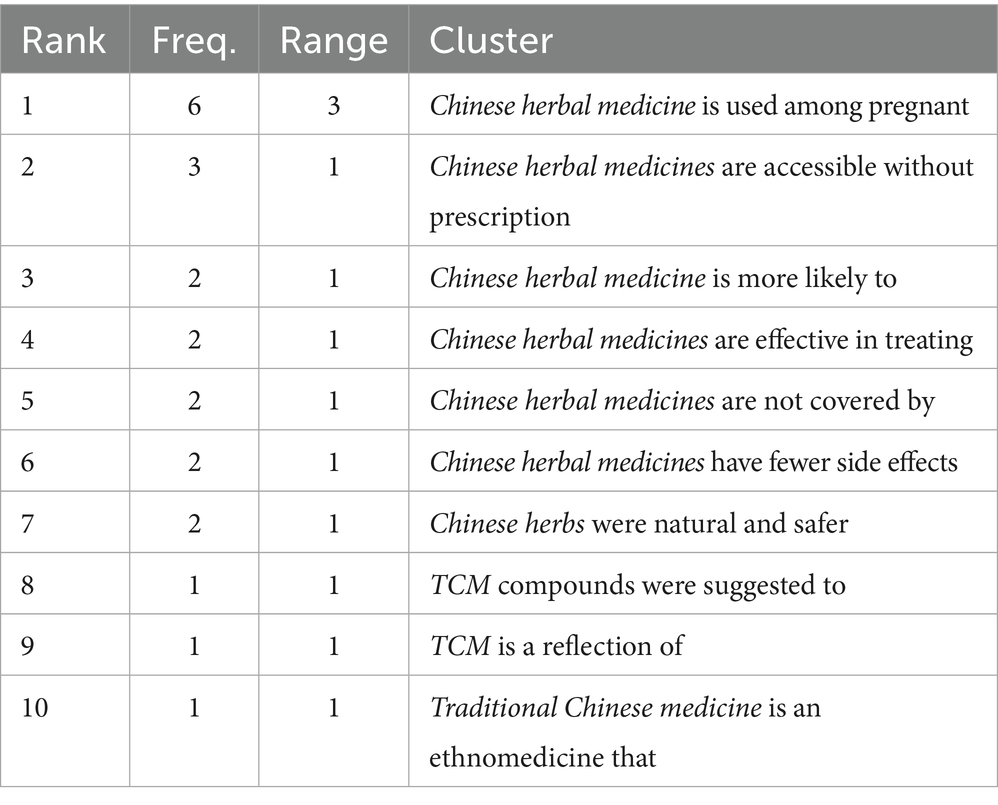
Table 8. Top 10 five-word S-P clusters containing the conventional translations of “中医药” in the African sub-CTIEAA.
Chinese herbal medicines are widely used in Africa to treat diseases during pregnancy, partly due to their exemption from prescriptions, accessibility, affordability, perceived safety during pregnancy, and effectiveness compared with conventional medical treatments. African scholars consider Chinese medicinals as a potential COVID-19 inhibitor, bringing great hope for curing it. Furthermore, scholars from Ethiopia, Tanzania and other African countries have also examined the factors influencing the use of Chinese herbal medicines, pointing out a negative correlation between their usage on the one hand, and patients’ monthly income and education level on the other.
4.1.3.5 North American and Australian scholars’ attitudes towards TCM
Given the relatively small number of TCM-related articles by North American and Australian scholars during COVID-19, the two were combined for analysis. The North American and Australian sub-CTIEAA includes only 3 articles, totaling 18,568 tokens. The minimum frequency and range kept at “1,” the top 10 five-word S-P clusters with the conventional translations of “中医药” as the search term in the North American and Australian sub-CTIEAA are illustrated in Table 9.
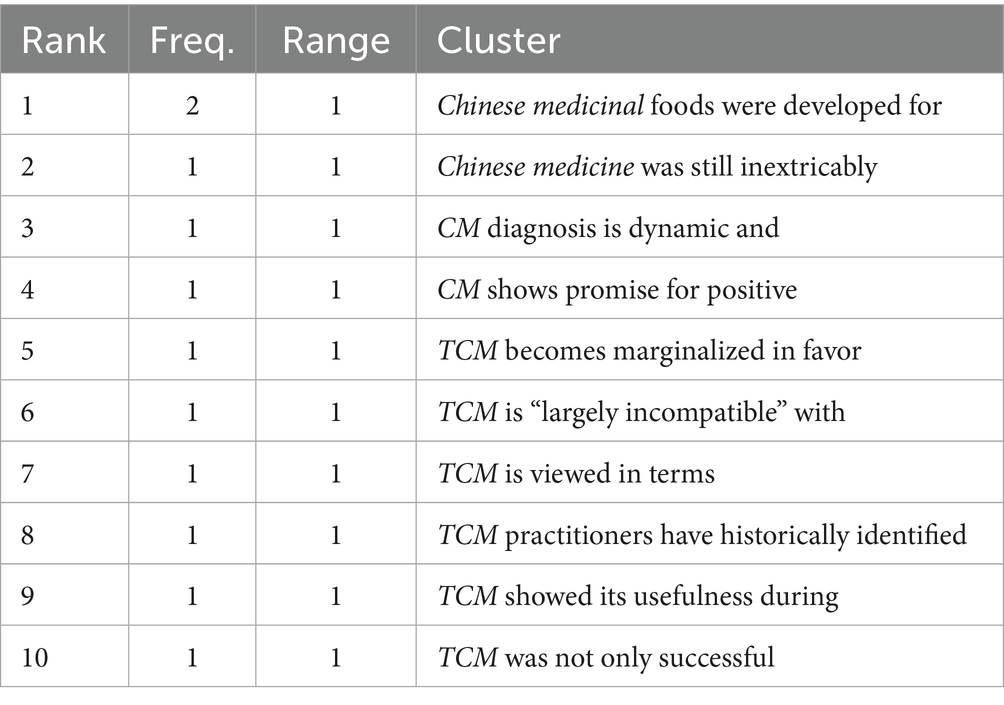
Table 9. Top 10 five-word S-P clusters containing the conventional translations of “中医药” in the North American and Australian sub-CTIEAA.
North American and Australian scholars point out that Chinese medicinal foods can be used to treat diabetes and other diseases. American scholars have designed a TCM + biomedicine-based nutrition curriculum, demonstrating its effectiveness in improving attitudes and dietary habits of Chinese Americans with type 2 diabetes. On the other hand, Australian scholars have found there is a disconnect identified by TCM acupuncturists between their clinical practice and the design of clinical trials, which may be attributed to the historical conflicts between the theoretical frameworks of biomedicine and TCM.
Close text reading indicates that, except for Australian scholars who maintain a relatively neutral position, those from other continents generally exhibit positive views on TCM, and this sentimental orientation is basically consistent with the findings of the above cluster-based attitude analysis.
4.1.4 Research focuses on TCM in academic discourse in different disciplines
Keywords are regarded as directional and visible “probes” that facilitate the detection of the subject content style and stance of a text (He and Guo, 2020). Keyword lists of discipline-specific sub-CTIEAAs can effectively reveal the differences in theme and focus on TCM in international English academic discourse across various disciplines.
4.1.4.1 Research focus of medical academic discourse on TCM
Two points need to be made clear. First, due to the generic commonalities in academic discourse, keyword overlaps across sub-CTIEAAs with general English as a reference are expected. Second, compared with other parts of speech, nouns, indicative of discourse’s “field,” provide a more direct reflection of the topic. Therefore, to reveal thematic differences as much as possible, with the other four combined as a reference corpus, a keyword list was generated for each observed sub-CTIEAA, in order to, after the non-nouns were eliminated, shed light upon the differences in research focus in a precise manner. The top 30 key nouns in the medical sub-CTIEAA are listed in Table 10.
Words like patients and treatment rank high in the list, indicating significant concern among international medical scholars regarding the role of TCM in maintaining patient health and treating diseases. Women’s health issues (women), especially the application of TCM in pregnancy and infertility treatment, have drawn notable attention. Numerous studies discuss various TCM syndromes, for instance, the correlation between deficiency syndromes (deficiency of both qi and blood, deficiency of yin / yang) and phlegm-statis constitution on the one hand, and disease course, severity and observation indexes on the other, aiming to offer personalized treatment for patients with different constitutions. The diseases primarily treated by TCM include common tumors such as liver cancer, kidney cancer and colorectal cancer (CRC) as well as diabetes. Many clinical trials (participants, respondents, subjects), mainly utilizing multiple groups with age, gender, etc. as parameters, investigate TCM’s influence on disease cure rates or survival rate. Additionally, there is growing interest in exploring the adjuvant and combination therapy of TCM as opposed to modern medicine among medical scholars who are generally convinced of their apparent advantages or potential over single traditional therapy.
4.1.4.2 Research focus of scientific academic discourse on TCM
Given the varied sizes of the discipline-specific sub-CTIEAAs, the scope of keywords to be examined was adjusted as appropriate. The top 20 key nouns in the scientific sub-CTIEAA are presented in Table 11.
A scientific portion of the academic articles on TCM adopt a perspective of environmental protection and sustainable development. They attempt to establish methods (MS, ion) to identify toxic or carcinogenic components in Chinese herbal medicines in chemical, biological and other fields, and quantify the content of pesticide residues (pesticides) and other toxins in samples through empirical research (°C, mg, ml, min, h). Exploration extends the application of new materials (O, Fe) in increasing the yield and active ingredient proportion in TCM, as well as low-cost and green synthesis strategies for medicinal ingredients (AgNPs) with Chinese medicinal decoctions and residues. Another area of focus is the compound screening (compounds) for specific prescriptions (GN) or medicinal materials (Fritillaria) as a pharmacological basis for disease treatment via integrated Chinese and Western medicine. In addition, the potence of Chinese herb extracts or genes (DobHLH, bHLH) in acting on potential targets for disease treatment (MSTN, eEF) is also evaluated.
4.1.4.3 Research focus of engineering academic discourse on TCM
The top 20 key nouns in the engineering sub-CTIEAA are listed in Table 12.
The high frequency of such terms as layer, input and feature indicates that engineering discourse mainly concern the development of models or algorithms based on the branches of artificial intelligence technology to address TCM-related challenges with the aid of information technology, especially big data. Examples include how to use neural network for text generation and deep learning for TCM prescription recommendation; how to use machine learning for TCM prescription classification, and data mining, topic models and other technologies to analyze prescription ingredients. Computer-assisted technology has been increasingly used for tasks such as correcting color differences and processing tongue images (graph) etc. in tongue diagnosis. The application of artificial intelligence has also been discussed in TCM entity identification, mixed teaching models of TCM, as well as massage devices that emulate TCM techniques.
4.1.4.4 Research focus of agricultural academic discourse on TCM
The top 20 key nouns in the agricultural sub-CTIEAA are listed in Table 13.
Starting from the practical problems of limited resources and ever-rising prices of and an increasing demand for wild medicinal plants, agricultural academic articles primarily explore methods (hairy root production) for large-scale artificial cultivation and optimization of compound extraction (CFs, flavonoids, extracts) of Chinese medicinals, as well as the impact of environmental pollution (concentrations of Cd) on their growth and active ingredients. Attention has also been paid to the role of Chinese herbal medicines (Hozen, indigotica) as feed additives (CCHMA) and veterinary drugs in enhancing livestock immunity (calves, dogs, geese), treating animal diseases, and improving the quality of animals and their products (milk, colostrum). Moreover, there are also studies focusing on the mechanisms of action of animal-based Chinese medicinals (ghost moth, larvae) and the design and testing of Chinese herb harvesters (roller, stalk).
4.1.4.5 Research focus of humanistic academic discourse on TCM
The top 20 key nouns in the humanistic sub-CTIEAA are listed in Table 14.
Humanistic academic articles predominantly investigate learners’ understanding and mastery of TCM terminology from a language teaching perspective (TCM, learners, words, students). Scholars are also concerned about the methods and standards for the English translation of terminology (English, translation) in specific fields of TCM (CMTZ). Keywords such as health, hospitals, expectation, efficiency and DEA indicate that research also extends to the rationality of the allocation of TCM health resources and the effectiveness of services provided to patients in China. In discourse studies, particular attention has been paid to TCM evaluation. To be specific, attitudes and sentiments of people from all walks of life towards TCM are obtained through social platforms (Weibo), expert consultations (experts) and other channels. Nevertheless, it’s noteworthy that the word science signifies ongoing controversies in humanities regarding TCM’s classification as a science.
4.2 Discussion
Between 2020 and 2022, there was a substantial increase in the number of academic institutions, journals, publications and disciplines related to TCM research. Although neutral or even extreme negative perceptions still exist, scholars from various regions generally hold a positive attitude towards TCM, particularly recognizing its invisible role in response to COVID-19. This finding, compared with those from previous TCM representation research in media discourse, presents a more optimistic picture. And continent-specific explorations of TCM academic articles provide a more nuanced perspective beyond the conventional East–West dichotomy commonly used in previous comparative studies. Moreover, scholars worldwide of major disciplines have all paid extensive attention to TCM, proposing distinctive focuses in their respective research fields. The observed variations in the academic framing of TCM across different regions and disciplines may be understood against the backdrop of medical systems, cultural and geographic proximity, institutional factors, status quos of TCM research and practice as well as disciplinary conventions.
4.2.1 Medical systems
Medical systems appear to play a crucial role in TCM representation. For example, China’s medical system has always been committed to promoting the coordinated development of TCM and Western medicine, and incorporating it into the national medical and health system through the formulation of relevant policies and regulations. In contrast, Japan and Korea maintain a relatively cautious stance, partly attributed to the later development of their independent traditional medical systems, albeit influenced by Chinese culture and medicine.
4.2.2 Cultural and geographic proximity
While medical systems form an important framework for understanding national stances, cultural and geographic proximity may also help account for variation in TCM’s academic representation. Countries within the Sinosphere—such as Japan and South Korea—have historically maintained close cultural ties with China. Although these countries have later developed independent systems (Kampo and Hanbang), they initially incorporated elements of TCM, and their shared philosophical foundations have arguably fostered greater acceptance. As reflected in this study, academic publications from East Asian regions tend to portray TCM more favorably than those from Europe or North America, where biomedical epistemologies dominate and traditional medicine is often marginalized.
4.2.3 Institutional factors
Furthermore, institutional and geopolitical factors may shape evaluative patterns, which can be exemplified by the complex perceptions of TCM in Australia and the United States. Australia mandated scientific validation for all Chinese medicinals promoted for COVID-19 infection, but allowed doctors and patients autonomy in choosing TCM treatment. The United States initially approved clinical trials of some Chinese medicinals. However, TCM has failed to be popularized to fight against the pandemic because of the FDA’s later statement regarding the insufficiency of scientific data to support its efficacy.
4.2.4 Status quos of TCM research and practice
The uneven advancement of TCM theory and clinical practice across regions has contributed to varied academic discourse patterns. Originating in China, TCM with its unique theoretical system has long provided a set of solutions for Chinese people’s health. Nevertheless, of European countries, with the exception of the UK which encouraged the integration of traditional Chinese and Western medicine in the treatment of COVID-19, others advocated for further research, though convinced of TCM’s potential. This stems from the fact that TCM is not prevalent in Europe and thus is yet to be verified and recognized. African scholars’ attitudes vary by country. Due to limitations in medical resources and cultural beliefs, some African countries exhibit an insufficient awareness of TCM, and may be more inclined to local traditional medical solutions, hence a relatively low level of acceptance.
4.2.5 Disciplinary conventions
Although not a primary factor, disciplinary conventions may also influence the representation of TCM. For instance, fields such as clinical medicine and pharmacology exhibit a strong preference for evidence-based paradigms and systematic validation procedures, often requiring randomized controlled trials to substantiate claims. This helps explain the significance of participants, respondents, subjects, groups and age in the key noun list of the medical sub-CTIEAA.
5 Conclusion
Needless to say, in face of internal limitations in modernization and standardization, as well as external barriers in international market access, there is still a long way to go to enhance the international TCM academic image. To promote the global dissemination of TCM knowledge and culture, it’s imperative to enrich TCM theories, conduct in-depth research on the medication rules and mechanisms of Chinese medicinals before ensuring and proving their safety and effectiveness, develop green recycling strategies for residues, and strengthen the protection of wild species. Efforts should also be made to enhance research innovation and international cooperations for an all-round medical system. It’s also a must to strengthen international education, publicity and research publication, so as to improve international scholars’ understanding of TCM.
Data availability statement
The original contributions presented in the study are included in the article/supplementary material, further inquiries can be directed to the corresponding author.
Author contributions
JP: Conceptualization, Data curation, Formal analysis, Funding acquisition, Investigation, Methodology, Project administration, Resources, Software, Supervision, Validation, Visualization, Writing – original draft, Writing – review & editing.
Funding
The author(s) declare that financial support was received for the research and/or publication of this article. This work was supported by the 2023 Co-constructed Project of Guangzhou’s “14th Five-Year Plan” for Philosophy and Social Sciences Development: Research on the Image of Guangzhou Enterprises in Social Responsibility Discourse and its International Communication in the Epidemic Era (Grant No. 2023GZGJ236), and the First-Level Discipline Capacity Enhancement Project of the “Solid Foundation” Program under the 2025 “Peak Climbing and Excellence Building” Initiative of Guangzhou University of Chinese Medicine: A Diachronic Study of TCM Communication in Overseas Media from the Perspective of the Hierarchy of Effects.
Conflict of interest
The author declares that the research was conducted in the absence of any commercial or financial relationships that could be construed as a potential conflict of interest.
Generative AI statement
The author declares that no Gen AI was used in the creation of this manuscript.
Publisher’s note
All claims expressed in this article are solely those of the authors and do not necessarily represent those of their affiliated organizations, or those of the publisher, the editors and the reviewers. Any product that may be evaluated in this article, or claim that may be made by its manufacturer, is not guaranteed or endorsed by the publisher.
References
Baker, P., Gabrielatos, C., Khosravinik, M., Krzyżanowski, M., McEnery, T., and Wodak, R. (2008). A useful methodological synergy? Combining critical discourse analysis and corpus linguistics to examine discourses of refugees and asylum seekers in the UK press. Discourse Soc. 19, 273–306. doi: 10.1177/0957926508088962
Chen, L., Wu, X. W., and Li, M. (2018). Formation and fragmentation within a networked public sphere: social media debates on traditional Chinese medicine. Telemat. Inform. 8, 2219–2231. doi: 10.1016/j.tele.2018.08.008
Chen, Y. B., Zhu, X. J., Zhang, Q. X., and Liu, L. Y. (2022). Analysis of the news coverage of traditional Chinese medicine in the mainstream media of the UK and the US from the perspective of critical discourse. OAJRC Soc. Sci. 1, 102–110. doi: 10.26855/oajrcss.2022.07.022
Cyranoski, D. (2018). Why Chinese medicine is heading for clinics around the world. Nature 561, 448–450. doi: 10.1038/d41586-018-06782-7
Danell, J. A. B. (2018). “Translation of complementary and alternative medicine in Swedish politics” in Complementary and alternative medicine: Knowledge production and social & health implications. eds. C. Brosnan, P. Vuolanto, and J. A. B. Danell (Berlin: Springer), 165–191.
de Felipe, Í. O. (2021). The universality of science and traditional Chinese medicine. Sci. & Educ. 30, 1353–1370. doi: 10.1007/s11191-021-00249-4
Ge, H. W., and Tian, Y. L. (2022). Construction of TCM media image under the background of anti-epidemic – investigations based on the related external reports in China daily. J. Hanjiang Normal Univ. 1, 55–60. doi: 10.19575/j.cnki.cn42-1892/g4.2022.01.009
He, A. P., and Guo, G. H. (2020). A survey of corpus keyword approach in specialized discourse research abroad. Foreign Lang. Res. 1, 18–23. doi: 10.16263/j.cnki.23-1071/h.2020.01.002
Koppel, K., and Uibu, M. (2022). From witch-doctoring to holistic well-being: journalistic representations of three influential Estonian CAM doctors. Ethnol. Eur. 52, 1–27. doi: 10.16995/ee.3409
Lavorgna, A., and Di Ronco, A. (2018). Media representations of complementary and alternative medicine in the Italian press: a criminological perspective. Eur. J. Criminol. 15, 421–441. doi: 10.1177/1477370817748589
Luo, J. (2024). The image construction of traditional Chinese medicine from the perspective of discourse-historical analysis: a case study of the times and the New York Times. Mod. Linguistics 11, 735–741. doi: 10.12677/ml.2024.12111071
McEnery, T., and Hardie, A. (2012). Corpus linguistics: Method, theory and practice. Cambridge: Cambridge University Press.
Neuendorf, K. A. (2017). The content analysis guidebook. 2nd Edn. Thousand Oaks, CA: Sage Publications.
Pan, J. J. (2024a). A corpus-based comparative study of Chinese and Western media image construction of TCM-related personnel. Engl. Lang. Teach. 17, 71–83. doi: 10.5539/elt.v17n9p71
Pan, J. J. (2024b). Construction of TCM institution image: a corpus-based comparative critical discourse study of Chinese and Western mainstream media reports. Adv. Soc. Sci. Res. J. 11, 312–325. doi: 10.14738/assrj.118.17494
Qu, L. P., Li, X. L., Xiong, Y., Wang, Z., Zhou, Y. H., Zou, W. J., et al. (2022). Opportunities and hurdles to European market access for multi-herbal traditional Chinese medicine products: an analysis of EU regulations for combination herbal medicinal products. Pharmacol. Res. 186:106528. doi: 10.1016/j.phrs.2022.106528
Tang, J. W., Kuang, X. W., and Wei, R. N. (2025). Uncertainty avoidance, news genres and framing of traditional Chinese medicine: a content analysis of news from seven countries. J. Transcultural Commun. 3, 175–189. doi: 10.1515/jtc-2024-0004
U.S. Food and Drug Administration (2022). Dietary supplement products & ingredients. Available online at: https://www.fda.gov/food/dietary-supplements
Wang, D., Lu, J. H., Zhou, J. M., and Wong, V. K. W. (2024). “Useful or not?” the discussion of traditional Chinese medicine to treat COVID-19 on a Chinese social networking site. BMJ Glob. Health 9:e014398. doi: 10.1136/bmjgh-2023-014398
Xu, Y. Y., and Wei, N. X. (2024). Construction of China’s images in confrontational discourse: analysis of evidence from COVID-19 corpus. Foreign Lang. Res. 2, 22–30. doi: 10.16263/j.cnki.23-1071/h.2024.02.004
Yang, C. R., Yin, S. C., Cui, D., Mao, Z., Sun, Y. Q., Jia, C. X., et al. (2022). Quantitative evaluation of traditional Chinese medicine development policy: a PMC index model approach. Front. Public Health 10:1041528. doi: 10.3389/fpubh.2022.1041528
Ye, Q., Wu, Q., and Zhao, X. (2020). The ideological construction and knowledge dissemination of traditional Chinese medicine in online encyclopedia. Guiding J. Tradit. Chin. Med. Pharm. 8, 121–125. doi: 10.13862/j.cnki.cn43-1446/r.2020.08.035
Keywords: TCM, academic representation, international English academic discourse, corpus, post-COVID-19 era
Citation: Pan J (2025) International academic representation of traditional Chinese medicine in the post-COVID-19 era: a corpus-based exploration. Front. Commun. 10:1503708. doi: 10.3389/fcomm.2025.1503708
Edited by:
Anders Hansen, University of Leicester, United KingdomReviewed by:
Vittorio Tantucci, Lancaster University, United KingdomDimitrinka Atanasova, Lancaster University, United Kingdom
Copyright © 2025 Pan. This is an open-access article distributed under the terms of the Creative Commons Attribution License (CC BY). The use, distribution or reproduction in other forums is permitted, provided the original author(s) and the copyright owner(s) are credited and that the original publication in this journal is cited, in accordance with accepted academic practice. No use, distribution or reproduction is permitted which does not comply with these terms.
*Correspondence: Jiejing Pan, cGFuamllamluZ0BnenVjbS5lZHUuY24=
 Jiejing Pan
Jiejing Pan